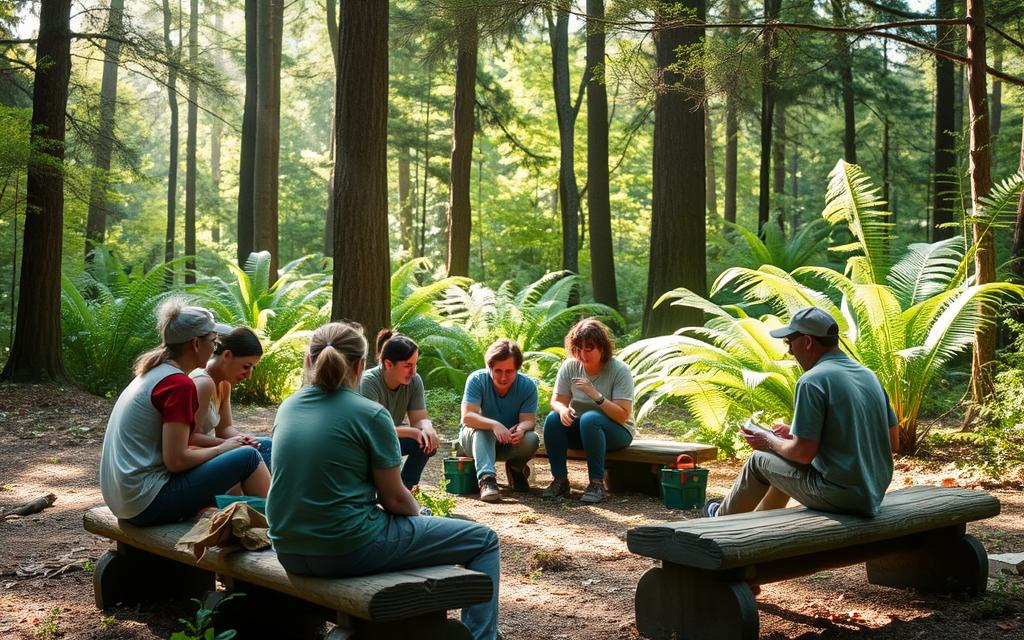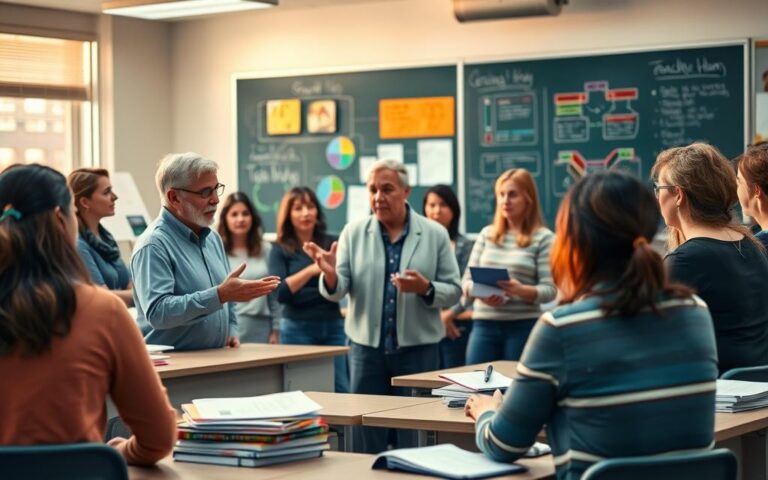advertisement
Environmental education programs are key in the United States. They help us deal with big issues like climate change and losing biodiversity. These programs teach us to make choices that help our planet and communities.
These efforts include school programs, after-school clubs, and nature workshops. They also include community projects and online courses. All these work together to teach people of all ages how to live sustainably.
Research shows these programs improve our knowledge and attitudes towards the environment. They also get us more involved in our communities. Studies from the North American Association for Environmental Education and EPA support this, showing outdoor learning improves our health and behavior.
The main goals of these programs are to teach us about the environment, encourage us to care for it, and develop critical thinking. We’re encouraged to look for local courses, support green schools, or join community efforts. This helps both people and the environment thrive.
Understanding Environmental Education
Environmental education teaches us about ecosystems and how we impact them. It helps schools and communities create programs that promote knowledge and action. These programs aim to raise awareness and encourage us to care for the environment.
Definition and Goals
Environmental education aims to teach us how to protect our planet. It focuses on making us environmentally literate and motivated to act. By linking science, policy, and personal choices, it helps us make sustainable decisions.
Key Components
Effective programs use a mix of subjects and hands-on learning. They combine outdoor activities, systems thinking, and inquiry-based methods. This makes learning about the environment real and engaging.
Community involvement and teacher training are crucial. Assessing how well programs work keeps them effective. Aligning with science standards helps meet educational goals while teaching sustainability.
Historical Context
In the U.S., environmental education started with conservation efforts in the late 19th and early 20th centuries. Outdoor education and nature centers made learning hands-on for kids and families.
The 1960s and 1970s environmental movement brought more attention and new teaching methods. The National Environmental Education Act of 1990 provided federal support for environmental education.
Today, guidelines from the North American Association for Environmental Education and UNESCO’s Education for Sustainable Development shape program design. State curriculum guidance and growing initiatives continue to influence environmental education in schools and communities.
The Benefits of Environmental Education
Environmental education programs teach learners about ecology and climate science in simple ways. They use short lessons, field trips, and school gardens. This makes complex ideas easy to understand.
Students who learn outdoors show better focus, deeper problem-solving, and better mental health. They gain real-world skills.
Individual Empowerment
These programs teach practical skills like gardening and energy saving. They boost confidence. When people apply what they learn, they make positive changes.
Changing behavior starts with awareness and personal connection. Then comes skill-building and changing social norms. Having chances to act is key.
A student who plants native species at school is more likely to compost at home. Small actions become habits with support.
Civic pathways emerge from hands-on learning. Internships and courses lead to careers in conservation and sustainability. Volunteerism and public service grow.
Community Engagement
When schools, parks, and nonprofits work together, communities benefit. Public workshops and restoration days unite neighbors. Community composting cuts waste and builds responsibility.
Green jobs and healthier neighborhoods follow. Stronger social ties help communities face climate challenges. Cities become more livable and adaptable.
Environmental education programs, eco-friendly initiatives, and outdoor learning form a network. They empower individuals and strengthen communities through knowledge and action.
Environmental Education in Schools
Schools play a big role in how kids see the world. By teaching sustainability in all subjects, they build lasting knowledge and habits. Teachers can use state standards and NGSS alignment to guide their lessons. They can also use model guides from NAAEE and EPA.
Curriculum Integration
Begin by weaving environmental topics into core subjects. Science classes can explore ecosystems and climate. Math can analyze data from local projects.
Language arts can include persuasive writing on conservation. Social studies can look at environmental policies. Electives might offer focused sustainability labs.
Districts should use NAAEE frameworks and EPA model curricula to align lessons. This makes assessments stronger and supports units that span subjects. Clear learning goals make environmental education a core part of the curriculum.
Hands-On Learning Experiences
Hands-on projects increase engagement and retention. School gardens, outdoor classrooms, and field trips apply concepts in real life. Citizen science platforms like iNaturalist and Project NOAH connect students to research and build data literacy.
Green schools programs like U.S. Green Ribbon Schools and Eco-Schools USA offer models for campus sustainability. These programs support energy efficiency, healthier schoolyards, and links between facilities and classroom learning.
Professional development gives teachers the time and tools to plan meaningful activities. University extension programs, NOAA lesson sets, and USDA resources offer ready-made modules and training. Strong networks help teachers adapt outdoor learning experiences to local needs.
Assessments should measure knowledge gains and behavior change. Use pre/post tests, surveys of recycling or transport habits, participation counts, and project outcomes. Combining quantitative and qualitative measures shows the impact of environmental education on students and communities.
| Strategy | What It Shows | Example Resources |
|---|---|---|
| Curriculum Mapping | Cross-subject learning goals and NGSS alignment | NAAEE frameworks, EPA model curricula |
| Outdoor Classrooms | Hands-on skills, increased engagement | School gardens, field trips, nature-based lessons |
| Citizen Science | Data literacy and community connection | iNaturalist, Project NOAH |
| Green School Initiatives | Whole-school sustainability, policy integration | U.S. Green Ribbon Schools, Eco-Schools USA |
| Teacher Development | Capacity to deliver quality lessons | University extension, NOAA, USDA training |
| Assessment & Evaluation | Evidence of learning and behavior change | Pre/post tests, behavior surveys, project metrics |
Role of Nonprofits in Environmental Education
Nonprofits are key in bringing environmental learning to schools, parks, and neighborhoods. They offer hands-on experiences and training for teachers. Many districts lack these resources.
These groups run programs that reach children and adults. They do this through partnerships and public events.
Leading Organizations
The National Environmental Education Foundation (NEEF) provides teacher training and resources. They also offer school partnerships to boost classroom confidence. The Nature Conservancy supports learning through habitat visits and community science.
Sierra Club connects youth to local conservation projects. Audubon Society delivers birding programs and curriculum. Local land trusts and nature centers offer field trips and after-school classes.
Program Models and Partnerships
Nonprofits use various models to reach learners. Mobile education units visit schools. Summer camps offer immersive nature experiences.
After-school programs keep children engaged all year. Community science initiatives invite public participation. These models are part of eco-friendly and green learning initiatives.
Funding and partnerships keep programs alive. Grants from foundations and corporate sponsors support programming. Public-private partnerships with schools and parks provide venues and staff.
Nonprofits often bridge funding gaps. They provide expertise and materials.
Volunteer Opportunities
Volunteers are crucial for program delivery and community ties. They help with citizen science, nature walks, and school garden care. Many organizations list volunteer openings on platforms like VolunteerMatch.
Volunteering builds skills and fosters stewardship. It supports nature-based education workshops and eco-friendly initiatives. Volunteers often become long-term advocates for green learning.
Measuring Impact
Nonprofits track success with clear metrics. They count program participation and measure knowledge gains. Restoration metrics monitor acres restored and species returned.
Long-term outcomes look at community engagement and sustainability behaviors. Evaluation helps refine programming and show funders the value of environmental education. Regular reporting ensures transparency and supports continuous improvement.
The Impact of Technology on Environmental Education
Technology changes how we learn about nature and science. Online platforms and digital tools make it easier for teachers and families to access environmental education. This way, students in rural or underserved areas can join lessons they couldn’t reach before.
Online Learning Resources
Big platforms offer courses on sustainability for all ages. Sites like Coursera and edX have classes from universities on climate science and conservation. The National Environmental Education Foundation (NEEF) and EPA provide free materials for students.
State education websites add local content to these resources. This makes learning more accessible and lets teachers mix online and outdoor lessons. Families can use short units to spark interest in local ecosystems.
Interactive Apps and Tools
Apps like iNaturalist and Seek by iNaturalist help identify species and log observations. GLOBE offers tools for classroom science projects. Eco-Schools digital toolkits guide school teams in green initiatives.
Energy-use tracking apps show how much energy a household uses and suggest ways to save. These apps make learning interactive and fun. Gamified features and real-time feedback boost engagement and help learners see the impact of their actions.
Citizen science platforms connect community efforts to big research projects. Projects on eBird and Zooniverse let volunteers help scientists by contributing observations and classifications. These platforms build data literacy and help scientists with useful data.
But, not everyone has equal access to technology. The digital divide can limit who can participate. To fix this, blended models, library partnerships, and device loan programs help make environmental education more accessible.
Environmental Education for Adults
Adult learning helps communities grow stronger. It teaches people how to protect the environment and use resources wisely. Classes and workshops are available, from university programs to local library events.

Workshops and Courses
Universities and Cooperative Extension Service offices provide ongoing education. Community colleges offer courses for those with busy schedules.
These courses cover topics like energy efficiency and native landscaping. Online platforms like Coursera also offer certificates for professionals.
Training is available for teachers and other professionals. It includes leadership and curriculum development. This helps improve local environmental education.
Community Programs
Local groups, libraries, and parks host workshops on topics like composting. These hands-on sessions teach people how to apply new skills at home.
Municipal programs offer training and incentives. This includes lower utility bills and stipends for volunteers. It encourages more people to get involved in eco-friendly education.
Adult education helps people make informed decisions. It supports neighborhood planning and household changes. This builds community resilience and improves outcomes.
| Program Type | Typical Host | Focus Areas | Common Incentives |
|---|---|---|---|
| Certificate Courses | Universities, Coursera | Sustainability planning, climate adaptation | Professional credits, career advancement |
| Evening College Classes | Community colleges | Energy efficiency, native landscaping | Affordable tuition, flexible schedules |
| Hands-On Workshops | Parks, libraries, nonprofits | Composting, rain gardens, audits | Tool lending, starter kits, stipends |
| Professional Training | Municipal agencies | Grant writing, curriculum design | Employer support, continued education units |
Engaging Diverse Audiences
Reaching learners from different backgrounds makes environmental education stronger. Lessons that connect to local lives and histories stick better. Programs that honor community knowledge build trust and have a deeper impact.
Cultural Relevance
Make lessons relevant by tying them to learners’ cultural backgrounds and local contexts. Use indigenous-led curricula that include traditional ecological knowledge. This shows respect for long-held practices.
Urban initiatives that focus on neighborhood air quality connect with residents facing environmental justice issues. Bilingual materials for Spanish-speaking families remove language barriers and boost participation.
Work with community leaders, school staff, and local elders to co-create content. Use neighborhood examples, local species, and foodways to make topics familiar. This approach helps green schools programs feel relevant, not foreign.
Inclusivity in Programs
Design activities that welcome participants of all abilities and incomes. Offer sensory-friendly nature trails, tactile kits, and captioned videos for learners with disabilities. Provide low-cost or free sessions, sliding-scale fees, and transportation support to reduce economic barriers.
Include different age groups through family days and intergenerational projects. Partner with community centers and libraries to expand reach. Tracking participation by demographics helps teams adjust outreach and improve inclusivity in programs over time.
Embed environmental justice topics into lessons to address unequal burdens on marginalized communities. Use participatory projects that let residents map local concerns, collect data, and propose solutions. These steps empower communities and create lasting change.
Measure reach and impact with simple tools. Collect demographic participation data, use brief feedback surveys, and form partnerships with community-based organizations for honest input. Iterate programs based on what families and leaders report, keeping equity at the center of design.
The Role of Government in Promoting Education
Public policy plays a big role in how we learn about the environment. Laws and plans at the federal, state, and local levels help support hands-on learning. Governments fund programs, set goals, and work with schools to make learning about the environment a part of everyday life.
Policies Supporting Environmental Education
The National Environmental Education Act is a key federal law for environmental education. Many states include sustainability in K–12 standards. This ensures students learn about climate and conservation.
Cities also have plans that include working with schools. These plans help teach the community about environmental issues.
Districts have policies for being green. They guide how schools buy products and design buildings. This helps teach science and civics through real-life examples.
Funding Opportunities
There are many ways to get funding, from federal grants to private foundations. The EPA and Department of Education offer grants for curriculum and teacher training. The National Science Foundation supports research and curriculum development.
State education grants and private foundations like the Walton Family Foundation help fund local projects. Grants can be for building capacity, implementing programs, or research. Strong plans and partnerships are key to success.
Working together with nonprofits, universities, and businesses can make a big difference. These partnerships help bring environmental education to more people. They help turn policy into action in the classroom.
| Program Type | Typical Funders | Primary Use | Tips for Applicants |
|---|---|---|---|
| Capacity-Building Grants | State education departments, private foundations | Staff training, planning, organizational growth | Show a clear timeline, list partners, include evaluation metrics |
| Program Implementation | EPA, Department of Education, local government funds | Curriculum delivery, field trips, materials | Detail student outcomes, budget by activity, demonstrate sustainability |
| Research & Curriculum Development | National Science Foundation, university grants | New curricula, assessment tools, pilot studies | Include peer partners, pilot sites, data collection plans |
| Public-Private Match Grants | Municipal programs, corporate partners | Facility upgrades, technology, community programs | Secure letters of support, outline matching funds, show community need |
Case Studies of Successful Programs
This section looks at U.S. programs that show how environmental education can be successful on a large scale. Each example talks about the program’s structure, who it serves, how it’s funded, its partners, and what it has achieved. Short summaries share lessons learned and how to apply these in new places.
Notable Examples
Eco-Schools USA combines learning with hands-on activities. Schools follow a seven-step plan, link lessons to state standards, and check energy, waste, and biodiversity. Funding comes from school budgets, PTA grants, and local utility rebates. The National Wildlife Federation and local groups help out.
The Nature Conservancy offers programs that mix classroom learning with field trips. These programs focus on middle and high school students, teaching about watersheds and restoration. Funding comes from foundations and local chapters. Teachers get training and ongoing materials.
Audubon’s youth birding programs mix science with classroom learning. They recruit diverse youth, give them binoculars and training, and connect them with local chapters. Support comes from Audubon chapters, local sponsors, and volunteers.
New York City’s Schoolyards to Playgrounds turns urban school grounds into outdoor classrooms. The program works with city agencies, nonprofits, and schools. Grants come from the city and philanthropy. Schools see more outdoor learning and student engagement.
The Chesapeake Bay Foundation teaches environmental lessons in Mid-Atlantic schools. The program includes classroom lessons, field trips, and community events. Funding comes from state education funds, foundations, and the Bay Foundation. Students help restore habitats.
Measurable Outcomes
Evaluation data show clear changes in knowledge and behavior. Eco-Schools USA sees a rise in environmental literacy scores after a year. Many green schools save 10% to 30% on energy and water after upgrades.
Field-based programs from The Nature Conservancy and the Chesapeake Bay Foundation see more people helping with restoration. Students contribute to planting native species and reducing erosion.
Audubon and similar programs track continued involvement. Many participants go on to volunteer or work in conservation within five years. Nature-based education improves observational skills and stewardship intentions in youth.
| Program | Structure | Primary Audience | Funding & Partners | Key Measurable Outcomes |
|---|---|---|---|---|
| Eco-Schools USA | Curriculum-linked projects, audits, site greening | K–12 students and teachers | National Wildlife Federation, district funds, grants | 10–25% energy/water savings; higher environmental literacy program scores |
| The Nature Conservancy (school programs) | Classroom modules + field experiences, teacher training | Middle and high school students | TNC chapters, foundation grants, local partners | Increased watershed knowledge; higher restoration participation rates |
| Audubon Youth Birding | Citizen science, training, field surveys | Youth ages 10–18 | Audubon chapters, sponsors, volunteers | Improved species ID skills; sustained volunteerism and career interest |
| NYC Schoolyards to Playgrounds | Urban greening, outdoor classrooms, community design | Urban elementary and middle schools | City agencies, nonprofits, philanthropy | Increased outdoor learning hours; biodiversity in schoolyards |
| Chesapeake Bay Foundation Curriculum | Estuary-focused lessons, field trips, restoration events | Mid-Atlantic K–12 students | CBF fundraising, state funds, foundations | Measurable habitat restoration; higher stewardship behavior rates |
Lessons learned show what makes programs successful. Strong partnerships and teacher training are key. Long-term funding and culturally relevant materials also help.
Replicating these programs requires adapting to scale and cost. Activities like schoolyard surveys and low-cost gardens are scalable. Nature-based education can use low-cost tools for monitoring. Green schools programs work best with clear goals and local support.
Overcoming Challenges in Environmental Education
Environmental education programs face many challenges. School budgets are tight, and grants are short-term. This makes it hard to grow.
Teachers have little time for new lessons because of high-stakes testing. Digital divides and transportation issues also limit participation.
Funding Limitations
Many classrooms struggle with tight budgets or one-off grants. This makes planning for the long term difficult.
Programs need to find different ways to fund themselves. Grants, corporate sponsorships, and PTA fundraising can help.
Showing how environmental projects save money can attract funding. This can come from school districts or local businesses.
Integrating environmental content into existing courses can save money. Short, modular lessons that fit standards can also reduce teacher prep time.
Partnering with companies like Patagonia or local utilities can provide materials and funding for eco-friendly education.
Ensuring Accessibility
Access barriers include physical, economic, and digital issues. Sites without ramps and programs with high fees can exclude people.
Sliding-scale fees, free sessions, and transportation stipends can help. Lending devices and offering classes at convenient times can also help.
Designing sites and materials that are accessible from the start is key. Use simple language, captioned videos, and sensory-friendly field experiences.
Partnering with community centers and libraries can help reach families with limited mobility or internet.
Institutional and Measurement Barriers
Teachers often have to focus on tested subjects. This can leave little room for environmental topics.
Cross-curricular lessons can link science, math, and language arts to tested subjects. Short activities that meet standards can fit into busy schedules.
Measuring long-term outcomes can be expensive. But simple surveys and reports from local partners can provide useful data.
Universities often partner on evaluation, offering rigorous measurement at a lower cost than in-house studies.
Building Sustainable Programs
To survive beyond seed funding, programs need to become part of the institution. Building coalitions with nonprofits, school leaders, and businesses is key.
Training volunteers and staff is crucial to keep programs running. Embedding eco-friendly education into school plans and district policies can secure support.
Success comes from diversified funding, inclusive design, and measurable outcomes. This mix helps programs overcome challenges and ensure everyone can participate.
The Future of Environmental Education
Environmental education is evolving quickly. New tools, changing careers, and global teamwork are shaping how we learn about our planet. This section explores key trends and offers global views on what’s next.
Trends and Innovations
Now, learning combines online modules with hands-on fieldwork. This approach makes education more accessible. Citizen science projects and big-data initiatives let learners contribute to real research through platforms like iNaturalist.
Augmented and virtual reality offer immersive field trips for students who can’t travel. These technologies make learning feel real. Programs also focus on building stewardship and well-being through nature-based practice and social-emotional learning.
The demand for sustainability careers is growing. This is pushing the development of vocational training and certificate programs. Sustainability education courses are now available in community colleges and corporate training, focusing on systems thinking, climate justice, and circular economy concepts.
Global Perspectives
U.S. innovations are part of a global movement. UNESCO’s Education for Sustainable Development sets shared goals. The European Union supports environmental education through funding and school networks that share best practices.
Countries like Sweden and New Zealand show how to integrate nature into daily schooling. International citizen science collaborations connect classrooms worldwide, building a global data commons.
| Focus Area | Emerging Practice | Global Example |
|---|---|---|
| Blended Learning | Online lessons combined with outdoor labs | Sweden: school nature days |
| Citizen Science | Public participation in data collection | iNaturalist global projects |
| Immersive Tech | AR/VR field simulations for remote learners | New Zealand: virtual field guides |
| Workforce Training | Certificates and vocational sustainability courses | Germany: green apprenticeships |
| Policy & Networks | International frameworks and funding streams | UNESCO: Education for Sustainable Development |
Technology can make high-quality education available to more people through mobile apps and online platforms. It’s important to close the digital divide to ensure everyone has equal access. Global networks and exchange programs help educators share knowledge and methods.
A long-term vision sees environmental learning integrated into K–12 standards, adult education, urban planning, and corporate training. Sustainability education courses will prepare a more informed and resilient public to face challenges and opportunities.
How to Get Involved
Starting with small steps, you can join environmental education programs. Talk to your school’s PTO about green schools or contact the parks department for workshops. Visit your local nature center to find volunteer roles. You can also check out the North American Association for Environmental Education or VolunteerMatch for nearby chances.
Volunteer tasks fit many schedules. You can help in classrooms, lead field trips, maintain gardens, or restore native plants. The time you give can be short or long, depending on your availability. If you can’t volunteer much, consider donating materials, sponsoring a garden, or offering professional services for free.
Supporting these programs is key to making a bigger difference. Go to school board meetings, sign petitions for new curricula, and apply for grants. Reach out to local officials to ask for funding or policy support for these programs. Also, support initiatives that make education and climate action more accessible.
If you’re looking for a career, think about getting a certificate in sustainability education or taking courses at a university. You can also work with groups like Audubon or The Nature Conservancy for training. Next, sign up for a workshop, volunteer at a garden, or ask your school to start a green program.



